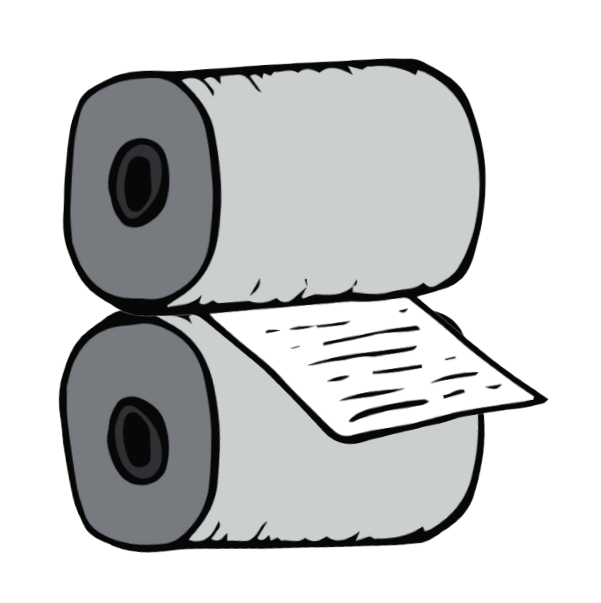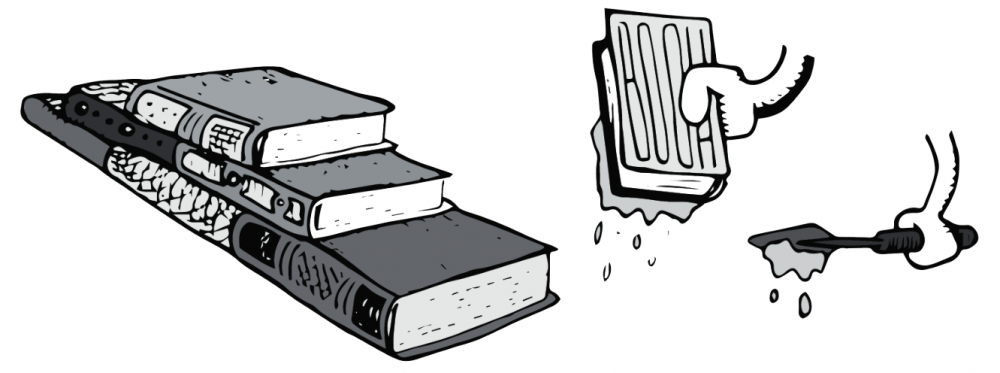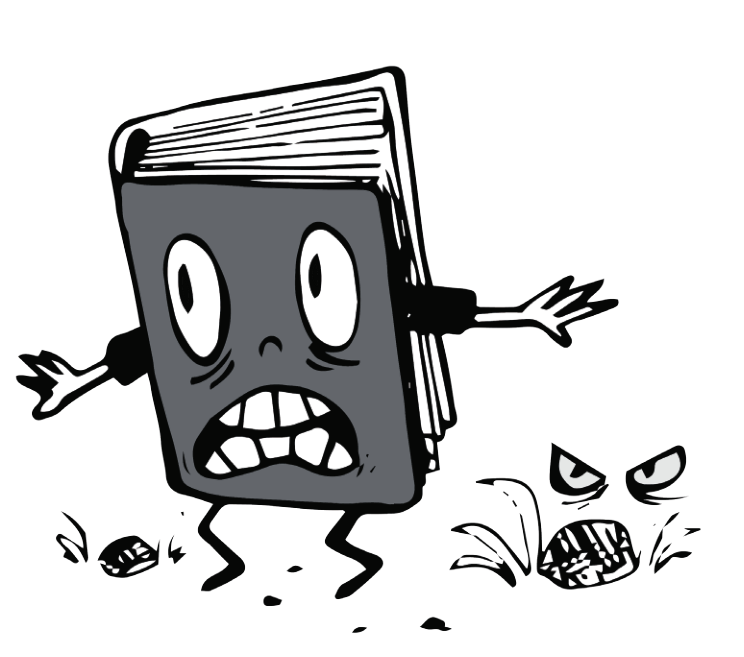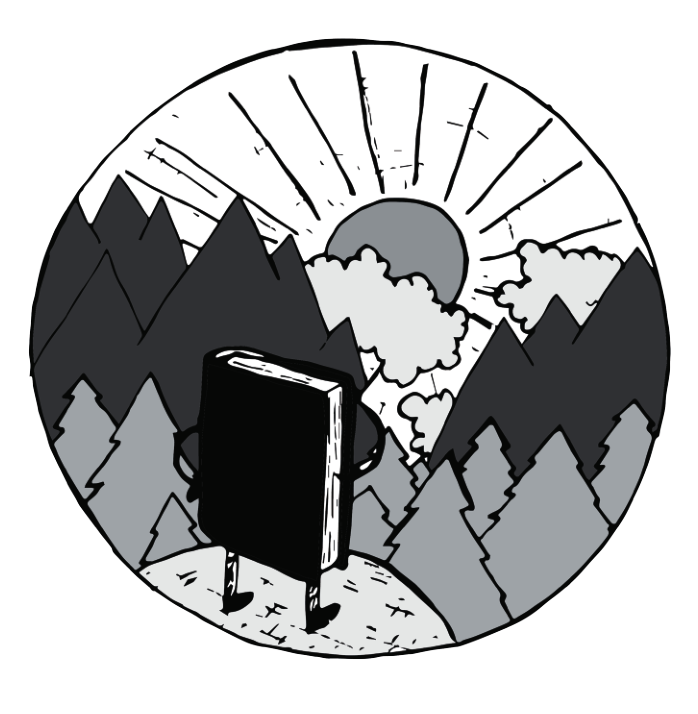I’m a published novelist, and these days, that’s not nearly as impressive as it sounds. Don’t get me wrong, I’m proud of all the hard work and countless hours I put into making my books as good as they could be, but actually being published? Well, it doesn’t have to be years of waiting and countless rejection letters anymore: in a matter of days, or even hours, anyone can have their book sitting on Amazon, next to the latest from Stephen King — although selling as many copies as him might be another matter. I’ve written three books, self-published one, and although I spent far longer than a few days on the process, let me tell you: the self-publishing is not the hard part.
The internet is absolutely full of advice on how to write a book, so here’s the condensed version of everything I’ve learned: write every day (except when you need breaks), have a detailed outline (unless you write better spontaneously), edit as you go (unless it kills your momentum), and finish what you start (actually do this).
Okay, now that you’ve finished your masterpiece, we can talk about self-publishing. The process has had a bad reputation for quite a while, but that’s starting to shift. There’s still a lot of self-published work out there that was in no way ready to see public release, but there are also more and more success stories, ranging from Lisa Genova’s Still Alice, to E.L. James’ Fifty Shades of Grey, to Andy Weir’s The Martian, all of which reached just as high heights as books from traditional publishers.
When I decided to look into self-publishing, I was cautious. Like everyone else who’s ever written a book, I “knew” mine was a bestseller waiting to happen, but I was scared of trying to sell it by myself, of releasing it without proper editorial support, and of having to muddle my way through a complicated business without anyone to guide me. And while those are all real hurdles, the discovery that pushed me over the edge was that traditional publishing (that is, getting an agent and a publisher) had almost all of them too. Gone are the days where every author is guided along and promoted heavily by the publishers. If you aren’t a proven bestseller, you’re pretty much on your own. While the editors are still there, new writers may just get a simple copyeditor pass (spelling and grammar, rather than content suggestions), and marketing will likely be limited to a listing on the publisher’s website. Your book might show up in bookstores, but only if bookstores are asking for it. As for marketing? Be prepared to make your own website, tweet constantly, and set up your own readings. The number of books traditional publishers are putting out is massive: industry analysis website Bowker projected 304,912 titles would be released in 2013, so having your book be number 304,913 doesn’t make it special, and doesn’t mean it’ll sell. Weighing my options, I decided the upsides weren’t worth a year or more of extra steps. Maybe I was impatient, maybe I was sick of working on this book and wanted to move on to the next one, but at the time, self-publishing seemed like the clear answer.
Now, how was I supposed to do that?
Where to publish:

The first step of self-publishing turned out to be simply deciding how I wanted to do it, where I wanted the book to be sold, and if I wanted a paper version. If you’re happy with only an e-book, you’ll save yourself a ton of work, but for me, it was important to have a physical, paper and ink book that I could display on a shelf. I also wanted to make sure my book was for sale anywhere people were likely to look. With those criteria in mind, I settled on three websites: CreateSpace, Kindle Direct Publishing, and Smashwords.
CreateSpace is my sole source for physical books. The company is owned by Amazon, which makes the sometimes cumbersome website worth the hassle, since any book published through it can automatically be listed on the omnipresent online retailer. It’s also a print-on-demand service which means, rather than requiring me to buy dozens of copies of the book myself, hope they sell, and then take them to the post office to ship myself, CreateSpace handles everything. If someone buys my book from Amazon, it is printed and shipped directly to them, usually very quickly, which keeps the upfront costs minimal and means significantly less work for the author. Despite all of that, I still make a small amount more on a physical sale than I do on an e-book (but more on royalties later).
The other half of the Amazon formula is Kindle Direct Publishing (KDP), which is all but essential for self-published authors. While I wouldn’t recommend limiting yourself, if you only want to sell through one service, this is the one to pick. It’s also shockingly easy to use, which explains some of the less-than high quality work available on Amazon. However, while KDP will make your book available on Amazon, it’ll only be readable by people with Kindle e-readers, Kindle apps, or on their computers, not on other brands of e-readers.
Speaking of those other e-readers, there are an overwhelming amount of non-Amazon retailers for e-books. That’s where Smashwords comes in. In addition to their own reasonably active storefront, Smashwords acts as a distributor. You upload the book to them, and they send it off to Apple, Kobo, Barnes & Noble, and a whole bunch of other sites I’d never heard of before, but that I assume some people use. That means you can manage all of your information on those sites from this one place.
Laying the groundwork:

With the book finished, and the distributors selected, I was ready to get into the nitty-gritty of self-publishing. As it turns out, that just means spending a lot of time Googling how things work, and following the breadcrumbs those results give you to learn about steps you never would have even considered.
The first of those steps for me might not matter to anyone else, but it was a key part of my planning. I wanted to write under a pen name. I think it was a combination of fear that my book would be a flop and my well-learned knowledge that nobody knows how to pronounce my last name (hint: it’s like “my Joe”). As it turns out, releasing a book under a different last name is not difficult at all — while the publishing sites do require your legal name (for tax and payment reasons), all of them provide easy options to write under a pseudonym, likely due to the vast, vast amounts of erotica self-published every day under obviously fake names. My book didn’t fall into that category, but I was thankful that those authors paved the way for me to hide a bit.
After that, I got to wade into the wonderful world of numbers. There are a lot of numbers you need to consider if you’re going to peddle your words. Most of them involving money, but before any of that, you’ll need an International Standard Book Number, or ISBN. Or rather, you’ll need one for each version of your book. These are those 13 (formerly 10) digit numbers used by stores, libraries, or customers to identify your book, even if its title isn’t unique. If you read about getting an ISBN online, you’ll hear a lot of authors complaining that this is the most expensive step, but thankfully for those of us in Canada, that isn’t the case. Every country handles ISBN distribution differently, and while it costs $125 for each one in the U.S., they are handed out to Canadian authors like samples at Costco. The Canadian ISBN Service System (CISS) website just requires that you register as a publisher, and the hardest part is deciding what to call your “company,” since it’ll appear on all of your product pages.
The biggest hurdle in the numbers department, which I am incredibly thankful you only need to do the first time, is figuring out how U.S. tax law applies to you. Because all of the publishing sites are based south of the border, citizens from other countries are expected to pay a certain amount of taxes… except for those that, like Canada, have a tax treaty. However, to do business, you’ll need to register for an Employer Identification Number from the IRS, which means filling out a few pages of paperwork, mailing it off to the States, and waiting potentially months to receive it. I won’t lie. It’s a headache. But, if you’re planning to self-publish, don’t delay on this like I did. KDP’s help pages will do a good job of guiding you through what you need to know, and Google will easily answer the rest, as it’s a common issue to encounter.
Now we get to the fun numbers. One of the biggest questions people ask about self-publishing is how much money you’ll make. First off, if you’re planning to publish your book to make money, temper those expectations. This is a hard business, and while I’m not one of those people who thinks their craft is high art, and that money should never cross your mind, you do need to get fulfillment from the work itself, or you’ll likely have a miserable wake-up call at the end of all this. That said, you can definitely make some money. Pricing is a tough subject, but for e-books, the market seems to have settled on $2.99 USD. It seems low — I certainly had a hard time listing the result of a full year’s work that cheaply — but the accessible price point means you will see more sales from tentatively interested people than you would at, say, $9.99. For paper books, there’s a bit more wiggle room. I went with $12.99 USD, which kept my profit from each version similar, and seemed like a reasonable middle ground. At this price point, I get between $1.84 and $2.55 USD from each sale, depending on which site it’s from. When considerate people ask me where the best place for them to buy it is, I just tell them Amazon — not because I make the most, but because the bump to my sales rankings is worth more in theory than an extra 10 cents, and odds are good that they already have an account there.
Now of course, because standardization is apparently overrated, each of CreateSpace, KDP, and Smashwords all pay you in different ways. Smashwords, as is its way, keeps things basic and effective, handling all payment through PayPal, which is easy to set up, and can then be transferred to your bank account. KDP skips the middleman, and deposits directly into your bank account, which is convenient and easy to set up. CreateSpace, however, is the outlier here. While they offer direct deposit for U.S. authors, international authors can only be paid by cheque. Which is fine, except that they only send it once you’ve pass the $100 USD threshold. That might work for people doing steady business, but with my sales of paper books limited to friends and family, I ended up with about half that amount sitting in limbo, inaccessible, at the point where I doubted I’d see many more sales until I released another book. The only solution here, outside of getting a U.S. bank account, is to have the money deposited into the account of a trusted American friend, and then have them pay you. It’s far from ideal, and won’t be an option for everyone, but I’ve spoken to CreateSpace, and confirmed it isn’t against their rules.
Making it professional:

I had gone through all of the setup pages for my account and my book on these three sites, so I was ready to upload my files and hit publish, right? Not quite. Because these are automated systems rather than professional book designers, you need to put in the effort to make your book look as good as it can. There is still a stigma against self-published books, and an (understandable) fear of low-quality writing. Assuming my book was actually good, I set out to make sure the presentation matched the writing.
Formatting terrified me. All throughout the writing process, the idea of formatting an entire manuscript loomed over the end of the project, threatening to scare me off from even finishing the book. It’s intimidating, but I discovered it isn’t nearly as bad as it sounds. Each of the sites has their own style guidelines and requirements for design elements like margins, chapter breaks/headings, and linked tables of contents (for e-books), but they all have clear documentation that will walk you through what you need to know.
I also had to figure out how to get people interested enough in the book to spend their time and money on it. Funnily enough, that sounded much easier than formatting, but it was the bigger job. Because, while I’d just spent months on end writing, the level of fine-tuning I felt compelled to do for my book’s blurbs far exceeded anything in the actual novel itself. Despite having a handful of different outlines and summaries, none of them worked as a basis for a blurb. There were at least four or five versions, and I went over each one with a fine-toothed comb, weeding out any extra, or even just weak words, making sure I didn’t reuse any single word too many times, and trying to gauge (with the help of friends) which ones sounded the most appealing. The only way to figure out what to write is to read a lot of blurbs. Look at bestsellers to see how they grab attention, look at your favourites to see what they do and don’t reveal, and look at books towards the bottom of the sales charts to see what they’re doing wrong (if anything). I also wrote three versions: one sentence, one paragraph, and three paragraph, for when situations called for different lengths, and with each longer version, revealed a bit more. Where the short version might just say “A mistreated orphan learns that he’s a wizard and discovers a world of magic,” the long version can hint at some of the adventures he’ll run into along the way, mentioning trolls, magical sports, and three-headed dogs. If someone cares enough to read the whole blurb, reward them with more information, don’t just stretch out the same simple points.
However, potential readers won’t even reach your blurb if you don’t have a good cover to draw them in. There’s one piece of advice repeated over and over for self-published authors when it comes to covers: don’t design it yourself. Unless you’re a graphic designer, it’s hard to get the right level of objectivity, and since this will literally be the face of your book, it needs to grab the eye, and convey what you want it to. The other key thing to keep in mind is that your book won’t be sitting on bookstore shelves, proudly displayed at full size. It’s going to be a small thumbnail, on an online store, sharing the page with dozens of others as a reader quickly scrolls past, half-reading titles and glancing at covers. Complicated, intricate covers are great when you’re holding a book, but make sure whatever it looks like, it’s not just a jumbled mess when viewed at that small of a size. For my book, I hired a designer online, and I would recommend against asking your artistically talented friend to do it, unless you have a relationship where you can be honest and upfront if their work isn’t what you envisioned. Before commissioning a cover, be sure to read up on the requirements from each site you’re publishing on, particularly CreateSpace, as physical books have more restrictive needs in terms of size, ratios, and spine width. (You’ll need a final page count before you know how thick your book will be.) All of that said, you do still need to figure out generally what you want on your cover, even if you’re commissioning someone, because you need to give them instructions. Just like blurbs, take a look at what else is out there, and make as many notes on what you don’t want as what you do. If you have a little bit of money to invest in your publishing experiments, the cover is the place to do it.
Releasing it into the wild:

And finally, after months more of preparing what I’d considered a finished book, I came to the end of the road. My masterpiece was complete, my story ready to be shared with the world, and my finger hovered over the “publish” button. I was done. Except, I realized, if I wanted to get anyone outside of my social circles to buy the thing.
One common marketing tactic these days is offering a pre-order for you book, and the reasons for that are two-fold. First, it’s an easy excuse to build some hype, talk about the book a lot, and hopefully have people take notice. But the second, and less obvious benefit, is that for most sites, pre-orders count as sales on day one. That means that, on top of some sales you’ll hopefully get the day your book launches, everyone who’s already bought it will be added to that number. If you can even get 20 or 30 people, that puts you well ahead of the hundreds of other self-published books coming out every day, and could put your book on the radar of a few new potential readers. And if those readers buy it and tell a friend, and those friends post on Twitter, and that tweet gets shared… suddenly you could have a success on your hands.
However, maybe that’s just wishful thinking. I didn’t do a pre-order, and the reason why is incredibly dumb, so I hope you all pay very close attention here. You see, when you do all of your formatting for the paper book on CreateSpace, you go through an approval process to make sure it will print fine. At the end, you can (and should) order a proof copy to review for yourself. It’s exhilarating holding that first copy of your book, flipping through it to make sure everything looks right. But don’t get overwhelmed by that excitement, because when you’re happy with it, you’ll be tempted to hit “approve proof” on CreateSpace. Unfortunately, CreateSpace fails massively in this one department, and doesn’t tell you that “approve proof” really means “approve proof and publish.” Once you hit that button, your book’s heading straight for Amazon, and anyone can buy it. I did this, and accidentally released my book weeks earlier than intended, then had to scramble to get all of the e-book versions out at the same time and to write announcements. It was an incredibly stressful week, and while I doubt it made the difference between my book being a commercial success or failure, it’s not the way I wanted to release my first novel.
My messy launch aside, there’s another facet of promotion to consider, either once your book is out, or in the months leading up to your release: reviews. Reviews, particularly posted on Amazon, are incredibly important, because they give potential readers the sense that other people care about your book enough to read it. Reviews are also one of the most nerve-wracking things about writing a book. Throughout the whole writing process, I was thinking about what my family would think, yes, but the idea of hearing from strangers, without any reason to sugar-coat their criticisms, was terrifying, even though I knew I needed them. Getting reviews is actually not that hard, just time consuming. There are countless book bloggers online, and almost all of them will have a review policy posted on their website.
I used the website The Book Blogger List (bookbloggerlist.com) to find potential reviewers, who are helpfully listed by genre, and with descriptions of what they review. Some blogs on the list are no longer active, so be sure to check out when their most recent post is, and do also consider the quality of their reviews, since they will be appearing alongside your book. Most bloggers didn’t get back to me, lots turned me down, and a few asked me for a copy of my book. Then I waited. And waited, and waited, and waited. With my book out, I was busy making sure everyone I knew was aware of it, and I got a lot of nice feedback from friends and family, but I’d say you should expect to wait at least two or three months before you’ll see any reviews. Some were closer to a year. Eventually, though, I started to get emails, Twitter notifications, and just notice new reviews on my Amazon page. And every time one of those appeared, my heart would skip a beat. I’d anxiously rush to their blog to see what they said, and try to read as fast as I could while taking everything in, trying not to scroll to the bottom and reveal the score until I got there, but dying to know. Some of the reviews were critical, and one of them clearly had not finished the book. But let me tell you, the best compliment I have ever received was reading that someone started my novel one evening, and got so hooked that he had to finish it that same night. It got called a must-read, and was compared to Michael Crichton. And those compliments stick with you, because this is something you’ve probably spent at least a year working on at this point. Sure, the criticisms stick with me too, and make me look back on the book with some regrets, but they’re almost all issues I knew existed, or choices I consciously made, because nobody is going to be more critical about my book than I am. In the end, all the anxiety of seeking out reviews was absolutely worth it, and there are a few that I should print out and frame on my wall, because they made me the proudest I’ve ever been of my work.
What does the future hold?

The world of self-publishing, like anything else on the internet, is constantly changing. I self-published my book in late 2014, and since then I’ve written another. At this point, it’s sitting in CreateSpace, KDP, and Smashwords’ systems, just in need of a release date, but I haven’t set one yet. I was within days of launching the pre-order when I decided I should take another chance. I’ve done the self-publishing thing, so should I try it again, or should I try the other route? I spent the summer break researching how to write a query letter, and reaching out to agents all across Canada and the United States, seeking representation for my new book. Maybe they can help me find a publisher and get a great deal, and I’ll look back on self-publishing as a silly waste of time. But I don’t think that’s the case: even if my new path leads me somewhere, I wouldn’t have had the confidence to pursue it without seeing that I could release a book on my own, independant of the support offered by traditional publishers. I don’t have any illusions that my self-published book was a masterpiece, but I received enough positive feedback to believe that I also do have a shot at this. And I think anyone who has it in them to write a book, be that a novel, a memoir, or a collection of poetry, has it in them to self-publish. It’s easier than ever to get your words out to the world.

Jeff was The Cascade's Editor in Chief for the latter half of 2022, having previously served as Digital Media Manager, Culture & Events Editor, and Opinion Editor. One time he held all three of those positions for a month, and he's not sure how he survived that. He started at The Cascade in 2016.

